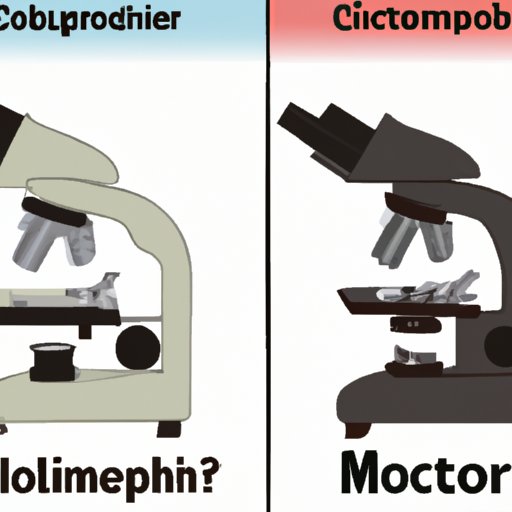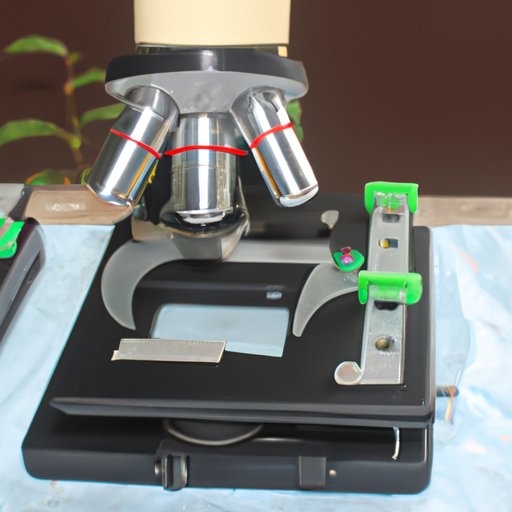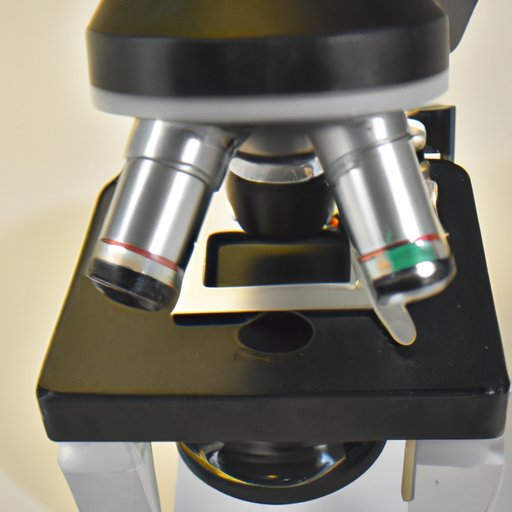Introduction
A microscope is an instrument used to magnify objects or images to a size where they can be observed more easily. It is an essential tool for scientists as it allows them to observe and study microscopic organisms and structures that cannot be seen with the naked eye. Microscopes are commonly used in science classrooms to teach students about the microscopic world and the importance of scientific research.
Exploring Different Types of Microscopes Used in Science Classrooms
There are several types of microscopes used in science classrooms, each with its own unique features and capabilities. The three most common types of microscopes used in science classes are compound microscopes, stereo microscopes, and digital microscopes.
Compound Microscopes
Compound microscopes are the most widely used type of microscope in science classrooms. They are composed of two or more lenses that are used to magnify an image. Compound microscopes have high magnification power and allow users to observe objects at very small sizes. They are also capable of producing clear and detailed images of specimens.
Stereo Microscopes
Stereo microscopes are designed to produce three-dimensional images of specimens. They use two separate optical paths that create a three-dimensional view of the specimen. Stereo microscopes are ideal for viewing larger objects such as insects, flowers, and other objects that require more depth perception.
Digital Microscopes
Digital microscopes are the newest type of microscope available and are becoming increasingly popular in science classrooms. Digital microscopes are equipped with a digital camera that allows users to capture images of specimens and save them on a computer for further analysis. Digital microscopes offer high resolution, making them perfect for detailed studies and observations.

A Comparison Guide to Choosing the Right Microscope for Your Science Class
When selecting the right microscope for your science classroom, there are a few considerations to keep in mind. You will need to consider the size and weight of the microscope, the magnification capabilities, the light source options, the resolution and clarity of the images, and the cost.
An Overview of the Most Commonly Used Microscopes in Science Classrooms
The three most commonly used microscopes in science classrooms are compound microscopes, stereo microscopes, and digital microscopes. Each type has its own set of features and benefits that make it ideal for science education.
Compound Microscopes
Compound microscopes are the most widely used type of microscope in science classrooms. They are composed of two or more lenses that are used to magnify an image. Compound microscopes have high magnification power and allow users to observe objects at very small sizes. They are also capable of producing clear and detailed images of specimens.
Stereo Microscopes
Stereo microscopes are designed to produce three-dimensional images of specimens. They use two separate optical paths that create a three-dimensional view of the specimen. Stereo microscopes are ideal for viewing larger objects such as insects, flowers, and other objects that require more depth perception.
Digital Microscopes
Digital microscopes are the newest type of microscope available and are becoming increasingly popular in science classrooms. Digital microscopes are equipped with a digital camera that allows users to capture images of specimens and save them on a computer for further analysis. Digital microscopes offer high resolution, making them perfect for detailed studies and observations.

How to Select the Best Microscope for Science Classes
When deciding which microscope is best suited for your science class, it is important to evaluate the different types of microscopes available. Consider the magnification capabilities, light source options, resolution and clarity, and cost of each type of microscope before making a decision. Additionally, it is important to analyze the features and benefits of each type of microscope to ensure it meets the needs of your science classroom.
Understanding the Advantages and Disadvantages of Different Types of Microscopes Used in Science Education
Each type of microscope has its own set of advantages and disadvantages. It is important to understand these pros and cons before deciding which type of microscope is best suited for your science class.
Pros and Cons of Compound Microscopes
Compound microscopes are highly versatile and offer high magnification power. However, they are often bulky and require a steady hand to operate. Additionally, they can be costly and require regular maintenance.
Pros and Cons of Stereo Microscopes
Stereo microscopes offer a three-dimensional view of specimens, making them ideal for viewing larger objects. They are also lightweight and easy to use. On the downside, stereo microscopes have limited magnification capabilities and may not produce clear images.
Pros and Cons of Digital Microscopes
Digital microscopes are the most advanced type of microscope available and offer high resolution images. They are also lightweight and easy to use. However, they are often more expensive than other types of microscopes and may require additional software or hardware to operate.

Examining the Different Features and Benefits of Microscopes Used in Science Classrooms
When selecting the best microscope for science classes, it is important to consider the various features and benefits that each type of microscope offers. Magnification capabilities, light source options, resolution and clarity, and cost are all important factors to consider when choosing the best microscope for your science classroom.
Conclusion
Microscopes are an essential tool for scientists and are commonly used in science classrooms to teach students about the microscopic world. There are several types of microscopes available, each with its own set of features and benefits. Compound microscopes, stereo microscopes, and digital microscopes are the three most commonly used microscopes in science classrooms. When selecting the best microscope for your science class, it is important to consider the magnification capabilities, light source options, resolution and clarity, and cost of each type of microscope. Understanding the advantages and disadvantages of each type of microscope is also essential in order to make the best decision.
(Note: Is this article not meeting your expectations? Do you have knowledge or insights to share? Unlock new opportunities and expand your reach by joining our authors team. Click Registration to join us and share your expertise with our readers.)
